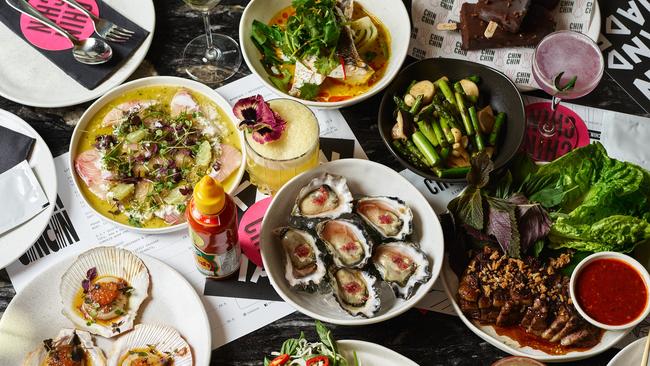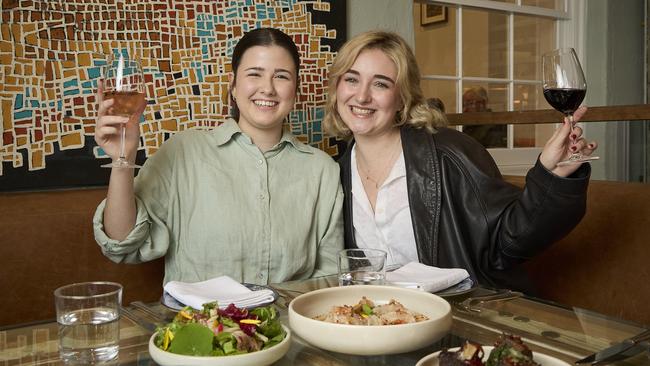Adelaide restaurants moving to set menus for smaller groups of diners as business costs escalate
How big should your dining group be before you’re forced to order the set menu? As the cost of living crisis grows, more restaurants are pushing them on smaller groups. Take our polls.
Food & Wine
Don't miss out on the headlines from Food & Wine. Followed categories will be added to My News.
Traditional a la carte dining for small groups of diners is being thrown on the backburner in favour of fixed-price menus as restaurateurs grapple with escalating business costs and staff shortages.
While set menus for larger groups of eight or more have been common in recent years, an increasing number of top Adelaide establishments are reducing the cut-off for a la carte to tables of five or six.

Among them is popular McLaren Vale restaurant The Salopian Inn, which now asks groups of six to commit to a set menu on weekends. The decision didn’t come lightly for chef/owner Karena Armstrong.
“For us, it was due to significant pay hikes within 12 months – nearly 15 per cent, and all the fixed costs (going up),” she said. “If we have a table of seven and they only pay $40 per head, we’ve just lost a lot of money.
“I’m battling against the fact we are one-owner operated restaurant, we don’t have another restaurant to offset costs; we’re not part of a group.”

The restaurant offers a $75 and $90 “feed me” menu, which is ever-changing and adaptable to diners’ requests. “If there’s a 90-year-old lady on the table who can’t eat that much food, they can have a piece of fish – it’s still hospitality,” Ms Armstrong said.
Other restaurants fixing per head costs for tables of six include the city’s Fugazzi and Shobosho, and Nido in Hyde Park; while Aldinga restaurant The Little Rickshaw has set the minimum group number to five, for all weekend tables.
The trend comes on the back of many restaurants switching to set menu-only through the Covid-19 pandemic. Some never switched back, such as Africola in the city, which asks all but sole diners to commit to an $85 fixed-price meal. Owner Duncan Welgemoed said the move made sense as 90 per cent of his diners opted for the ‘feed me’ option anyway.
“For us it’s great, because we’ve got a locked-in number; locked-in price, but also we can offer the value … you get to try pretty much every dish, you’re going to be super fed and it’s super value for money,” he said.
“There’s been no blowback, especially the way our menu is – it’s not like you come in and it’s so dogmatic that if you don’t like it, p*ss off. People can add extra dishes, or take out dishes.”
Restaurant & Catering Industry Association CEO Suresh Manickam said asking more tables to commit to a set menu was just one of the solutions being trialled by restaurants still reeling from the effects of Covid, particularly the skills shortage.
“Some of the people employed in restaurants (pre-pandemic) were overseas students, they were people working on 457 visas, they were backpackers. We haven’t had a return of those types of workers to take up the slack,” Mr Manickam said.
“That means restaurants are having to look at different ways of servicing customers and if they don’t have sufficient staff, they either have to set menus or reduce opening hours or sitting times.”
Regular diner Hannah Pendlebury, of Marion, said she and her friends recently opted against booking at a particular Adelaide restaurant because of the new set-menu rule.
“I do really enjoy the concept, it’s fun to see what the kitchen is most proud of and try an array of dishes but it doesn’t always suit the group,” the 32-year-old said.
“I was told that we had to do a set menu because we were a ‘large group’ of six people. This wasn’t at a fine-dining establishment; this was somewhere that predominantly serves pasta.”
When asked if more restaurants would ditch a la carte dining for set menus, Mr Welgemoed said, “potentially”.
“But restaurants should also look at the community they’re cooking for,” he said. “I don’t think Restaurant Botanic could work on an a la carte model, but an Italian joint opening for lunch probably wouldn’t go set menu either.”
Ms Armstrong said: “I don’t think restaurants are doing it to, ‘let’s make a lot of money’. It’s how are we going to survive? How are we going to have a thriving restaurant industry?”





